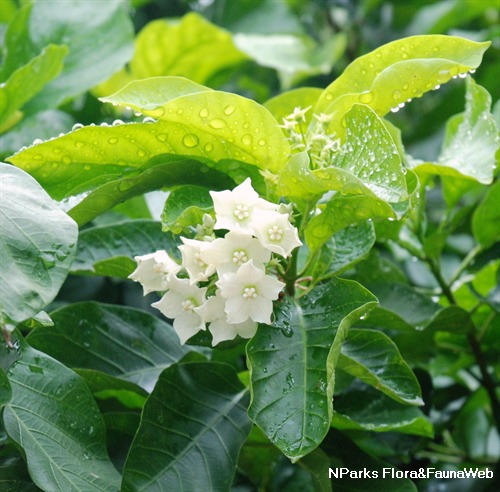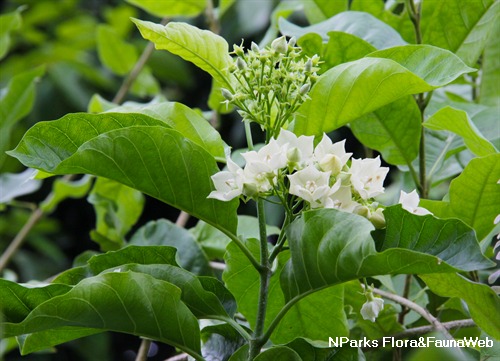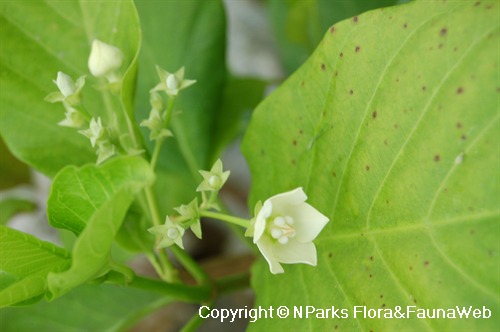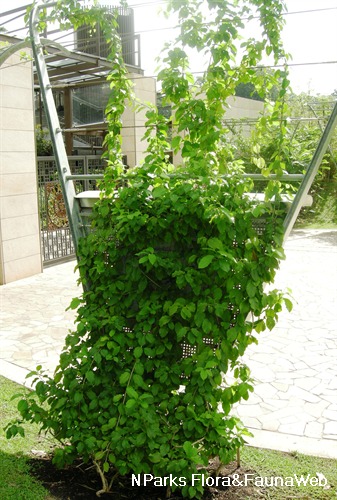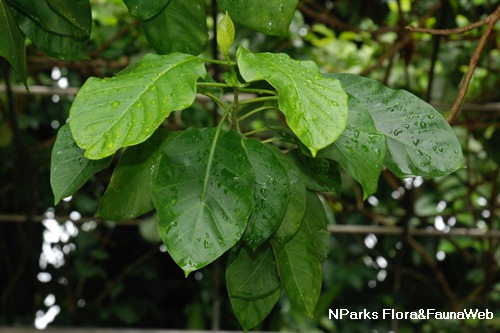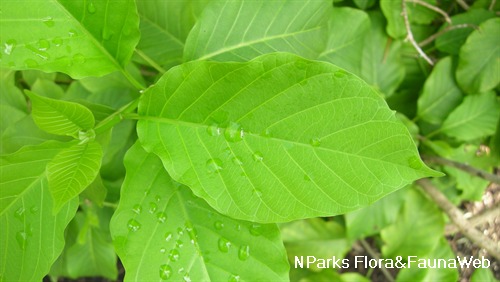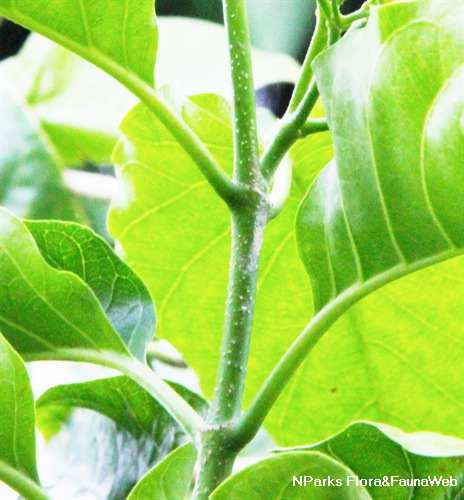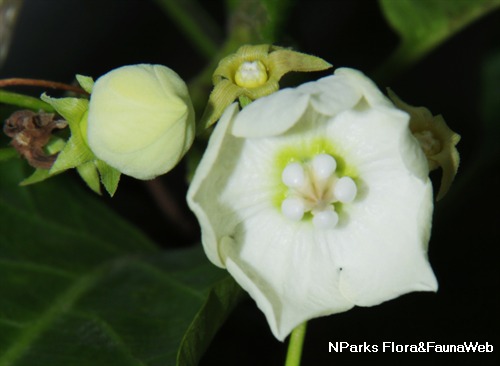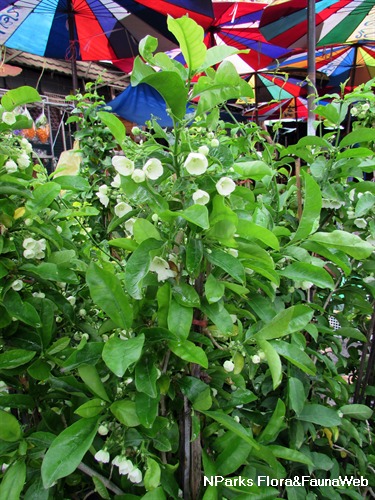.jpg)
Back
Vallaris glabra (L.) Kuntze
| Family Name: | Apocynaceae |
| Synonyms: | Vallaris pergulana |
| Common Name: | Bread Flower, Siku Dengan, Bunga Tongkan, Kerak Nasi, Bunga Kesidang, Kesedengan |
Name
Classifications and Characteristics
| Plant Division | Angiosperms (Flowering Seed Plants) (Dicotyledon) |
|---|---|
| Plant Growth Form | Climber |
| Lifespan (in Singapore) | Perennial |
| Mode of Nutrition | Autotrophic |
| Maximum Height | 2 m to 3 m |
Biogeography
| Native Distribution | Sumatra, Java, Lesser Sunda Islands. |
|---|---|
| Native Habitat | Terrestrial |
| Preferred Climate Zone | Tropical |
| Local Conservation Status | Non-native |
Description and Ethnobotany
| Growth Form | Evergreen, woody climber, which can growth up to about 2 - 3 m tall. |
|---|---|
| Foliage | Light green, glossy, opposite leaves are elliptic or ovate with wavy leaf margin. Leaf apex is acute or has a distinct drip tip. |
| Stems | Thin, woody stem has light grey, smooth bark. |
| Flowers | Flowers are borne in clusters of large, white cup-shaped flowers located near the tip of branches. The flower is about 1.0 to 1.5 cm in diameter, has 5 pointed, slightly overlapping petals. The outer edge of each petal is curled inward to form a sharp point in the middle. They open in the morning, but their Pandan or burnt rice-like fragrance is strongest in the evening. |
| Fruit | Oblong, beaked fruit splits into 2 dry, dehiscent fruits known as follicles. |
| Cultivation | This species is easy to grow and has a moderate growth rate. Plant this species in fertile, well-draining soil and space individuals 0.3 - 0.4 m apart. Provide a sturdy pergola or trellis to train plant to climb. It flowers best under full sun, because shady conditions inhibit flowering. Mulch the plants with compost to prevent the soil from drying out or the roots from overheating. Feed plants with a fertilizer rich in phosphorous to promote flowering. Avoid using nitrogen rich fertilizers, because they encourage development of leaves rather than flowers. Trim the branch tips after spent flowers to promote new growth and more flowering. |
| Etymology | The genus "Vallaris" is Latin for a garland given to the first soldier to climb over the enemy's rampart. The species epithet "glabra" means hairless. It refers to the upper surface of leaves which are generally hairless. |
Landscaping Features
| Landscaping | This species is popular for landscaping in Thailand and other countries in Southeast Asia. It can be trained to drape over a trellis or pergola. Alternatively, you can prune it into a bush. This species will grow well in a large container and is suitable for a sunny patio. It will attract butterflies as a nectar plant for butterfly gardens. The white flowers and intense evening fragrance would also make it suitable for a "Moonlight Garden" theme. |
|---|---|
| Desirable Plant Features | Ornamental Flowers, Fragrant (Flowers) (Night, Day) |
| Landscape Uses | Shade Providing Tree / Palm, Container Planting, Trellis / Arbour / Pergola |
| Thematic Landscaping | Moonlight Garden, Butterfly Garden |
| Usage Hazard - Cons | Irritant - Contact Allergy |
Fauna, Pollination and Dispersal
| Fauna Pollination Dispersal Associated Fauna | Butterfly-Attracting |
|---|---|
| Pollination Method(s) | Biotic (Fauna) (Insects (Bee), Insects (Butterfly, Moth)) |
Plant Care and Propagation
| Light Preference | Semi-Shade, Full Sun |
|---|---|
| Water Preference | Moderate Water |
| Plant Growth Rate | Moderate |
| Rootzone Tolerance | Fertile Loamy Soils, Well-Drained Soils, Moist Soils |
| Maintenance Requirements | Low |
| Propagation Method | Grafting, Air-Layering, Stem Cutting |
| Propagule Establishment Remarks | Propagate by layering. Secure the stem to the ground with a brick or similar object, and roots will form on the stem in about 2 weeks. The stem can then be separated from the mother plant and planted elsewhere. Alternatively, you can propagate by grafting. |
| Planting Distance | 0.3 m to 0.4 m |
Foliar
| Foliage Retention | Evergreen |
|---|---|
| Mature Foliage Colour(s) | Green |
| Mature Foliage Texture(s) | Smooth, Glossy / Shiny |
| Foliar Type | Simple / Unifoliate |
| Foliar Arrangement Along Stem | Opposite |
| Foliar Shape(s) | Non-Palm Foliage (Ovate, Oval) |
| Foliar Venation | Pinnate / Net |
| Foliar Margin | Entire |
| Foliar Apex - Tip | Acute, Acuminate |
| Foliar Base | Acute, Rounded / Obtuse |
Non - Foliar and Storage
| Bark Colour(s) | light grey |
|---|---|
| Mature Bark Texture | Smooth |
| Stem Type & Modification | Woody |
| Root Type | Underground (Tap Root) |
Floral (Angiosperm)
| Flower Colour(s) | White |
|---|---|
| Flower Symmetry | Radial |
| Individual Flower Shape | Bowl-shaped |
| Flowering Period | Free-Flowering |
| Flowering Opening Time | Daytime |
Fruit, Seed and Spore
| Fruit Classification | Simple Fruit |
|---|---|
| Fruit Type | Dehiscent Dry Fruit , Follicle |
Image Repository
Others
| Master ID | 233 |
|---|---|
| Species ID | 1529 |
| Flora Disclaimer | The information in this website has been compiled from reliable sources, such as reference works on medicinal plants. It is not a substitute for medical advice or treatment and NParks does not purport to provide any medical advice. Readers should always consult his/her physician before using or consuming a plant for medicinal purposes. |

.jpg)
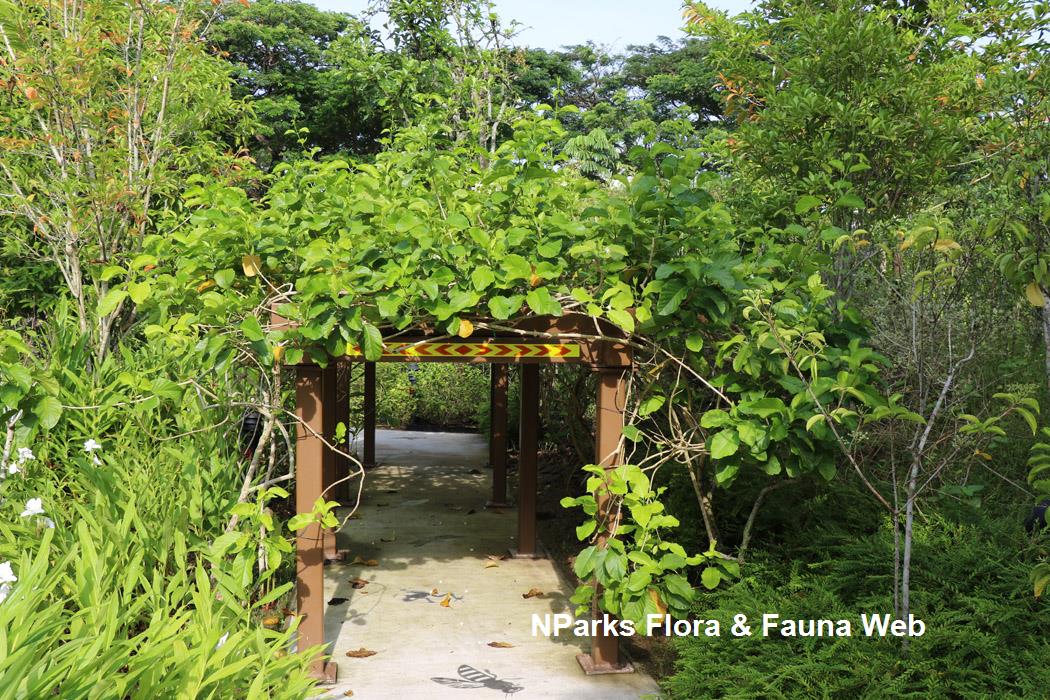
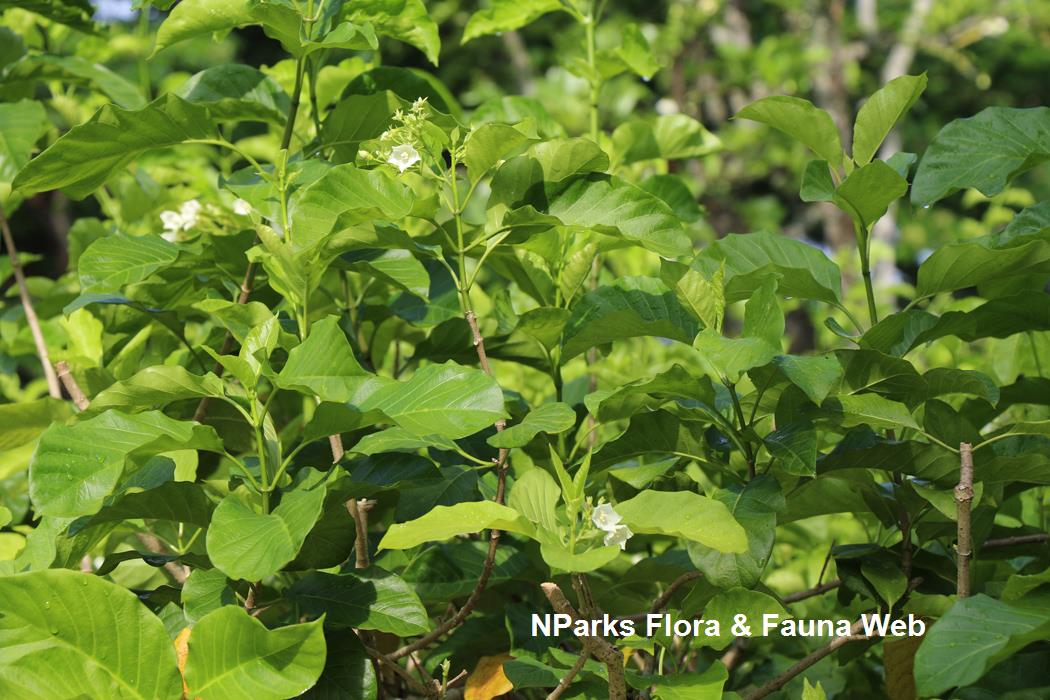
.jpg)
